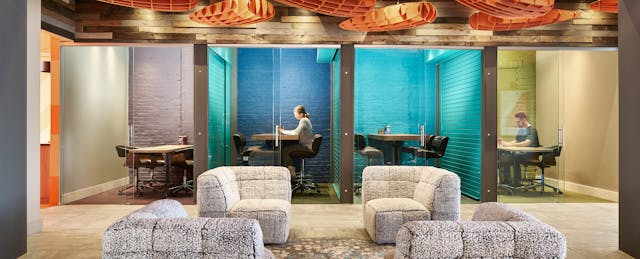When Gil Gibori searches for an analogy to describe the model behind his new premium tutoring center, The House, he’s apt to touch on a few big names, including WeWork, the Apple Genius Bar and, perhaps most unusually, the premium grocer Whole Foods.
Gibori has been in tutoring for a while. A biologist by training, he’s helped run an in-home tutoring company for more than a decade before securing his first physical location last year. After months of planning and building, The House recently opened in Glencoe, Ill., a well-heeled suburb north of Chicago, in a 5,000 square-foot space next to a yoga studio, a few blocks from Lake Michigan. The center serves kids in grades six to 12 and features onsite tutoring, and amenities including sleek, flexible furniture and a gourmet kitchen stuffed with snacks.
Also on call: a team of super tutors specifically hired to appeal to kids—mostly Ph.D. holders and candidates, often with colorful backgrounds (think former surfers, roadies and musicians).

“It’s the idea you’re taking the space and then layering over these dynamic tutors that have proven to the market that the more tattoos per square inch you have, the more kids respond to you,” Gibori says.
Tutors roam around and get pulled into 10-minute mini sessions with students on the fly. But they’re also available for longer sessions on demand or by appointment. Even though they share a space with students, Gibori opted against having kids physically flag down passing tutors in favor of something more closely resembling Apple’s Genius Bar, where on-demand appointments can be made via app. In this case, a custom-designed one called homework.sucks.
“We’re speaking to them in a language they understand,” Gibori says of students, “where even even if you’re ten feet from a tutor, they’d rather interact over their phone.”
For design inspiration, he drew from what Facebook and Google have done with their offices, and from coworking startups like WeWork, which mix couches and lounge areas with group work spaces and private rooms. The House has a similar modern feel but is designed to mimic a luxury home to make kids feel more comfortable. Gibori also sells the concept as a sort of youth hangout lounge with Wi-Fi, where kids don’t even have to study. Besides the snacks, there are weekend movie nights and parties after big events like final exams.
And parents aren’t just discouraged from tagging along—they’re outright banned.
“It’s not only a space that feels like home,” Gibori says, “it’s a space that feels like home without your parents there.”

Author and school design consultant Robert Dillon calls the variation in learning spaces—large tables, sitting areas and glass-walled breakout rooms—“micro-environments,” and says it’s similar to what districts around the country are attempting to create using open learning spaces and flexible furniture.
“I wish schools would have this level of intention around design, and that students themselves would engage and be excited about school as they are about this space,” says Dillon, who has warned against the dangers of buying flexible furniture without a vision for how they support learning environments.
Dillon is now serving as The House’s researcher in residence, and says he’ll take some of the concepts engineered there back to the St. Louis area school districts he works with. He acknowledges that public schools can rarely be as responsive as private business to something like space design, although there may be lessons to be learned.
And whatever else The House aspires to be, it’s still very much a business first, and the priority is on finding a sustainable business model while it seeks funding for local or even national expansion. Currently, it offers memberships for $350 a month, which includes on-demand tutoring and unlimited access to the center. There’s also an option for non-members to book one-off sessions with an outside tutor for a fee.
While general homework help is always in demand from students, tutors spend almost half their time helping teens prep for standardized tests, such as the SATs. That’s typical for a model that relies almost exclusively on middle- and upper-class families with more college-bound kids.

Currently, there are plans to expand to two additional Chicago locations, both in upmarket neighborhoods where median family incomes can exceed $300,000. Gibori is also seeking capital to fund a larger regional or even national expansion. But for that to happen, it has to be profitable—and by extension, privileged. That’s where he says The House is drawing from the growth of Whole Foods.
“It’s a model I’d like to follow because while Whole Foods has received a lot of criticism, it did teach the world the value of organic food,” Gibori says. “Now every supermarket in our area, no matter their price point, offers organic food. We are admittedly expensive, but our ethos is to be as inclusive as possible.”
Private tutoring is linked to better overall academic performance in students, but has also been termed part of the “shadow education system” that “commonly creates and perpetuates social inequalities,” according to a UNESCO report. New research also suggests that the widening class divide also impacts parents’ financial investment in their kids—meaning that as income gaps grow, poorer families spend less on activities like tutoring while wealthy families spend more.
Because The House is still in startup mode, Gibori says he’s unable to offer any of its seats to families that can’t afford the cost. (Members can, however, bring guests). As part of the effort to raise capital, he’s reached out to foundations to fund a program that serves students with social-emotional difficulties. And he’s floated the idea of using foundation funding—should it materialize—to put locations in economically disadvantaged areas, although such plans are a long way off.
“Right now it’s an expensive model to sustain,” Gibori says. “So we are placing it in affluent neighborhoods.”


